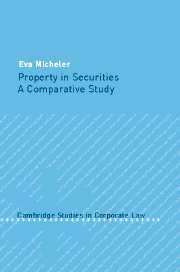Book contents
- Frontmatter
- Contents
- Preface
- Table of legislation
- Table of cases
- Introduction
- 1 Convergence and path-dependence
- Part I English law
- Part II German and Austrian law
- 9 The historic starting point
- 10 Paper transfers
- 11 Impact on the institutional framework
- 12 Immobilisation and its legal analysis
- 13 Evidence of convergence?
- 14 Conclusions on German and Austrian law
- Part III Conclusions
- Select bibliography
- Index
14 - Conclusions on German and Austrian law
from Part II - German and Austrian law
Published online by Cambridge University Press: 28 July 2009
- Frontmatter
- Contents
- Preface
- Table of legislation
- Table of cases
- Introduction
- 1 Convergence and path-dependence
- Part I English law
- Part II German and Austrian law
- 9 The historic starting point
- 10 Paper transfers
- 11 Impact on the institutional framework
- 12 Immobilisation and its legal analysis
- 13 Evidence of convergence?
- 14 Conclusions on German and Austrian law
- Part III Conclusions
- Select bibliography
- Index
Summary
The focus of part II of the book was the German and the Austrian law of securities. Securities are classified as tangibles in both German and Austrian legal doctrine and their transfers are governed by the same rules as transfers of tangible assets. This analysis is supported by the theory that the paper certificates which are traditionally issued for securities embody the entitlements to which they relate. The analysis appeared in the later part of the nineteenth century and became the orthodox theory prevailing in both Germany and in Austria after the German states and Austria had adopted rules protecting the bona fide purchaser against unauthorised issues.
Under both German and Austrian law, the buyer needs to acquire possession to the securities certificate in order to become the owner of the certificate and of the entitlement to which it relates. The buyer of securities is protected against adverse claims arising out of unauthorised transfers in the same way as the buyer of tangible movables; there also exists a rule protecting the buyer against claims arising out of defective issues.
In both German and Austrian law, the rule protecting the buyer of securities against unauthorised transfers imposes the risk of such transfers upon the owner of securities who loses her entitlement when a buyer in good faith and for value acquires possession to the securities documents.
- Type
- Chapter
- Information
- Property in SecuritiesA Comparative Study, pp. 220 - 222Publisher: Cambridge University PressPrint publication year: 2007



